Hozelock Guide to Garden Ponds
Welcome to Garden Ponds with Hozelock Cyprio. We hope that this site will guide you through our range and help you identify the right solution for your needs.
Below are six key topic areas, while the left hand bar gives details on specific product groups.
What Is The Secret To A Clear And Healthy Pond
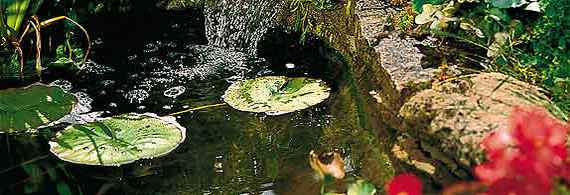
Any pond whatever the size and whatever the design will benefit from having clean, clear, healthy water.
A garden pond with plants, wildlife and fish, will flourish if the water is clean and healthy.
A formal pond with crisp lines will be enriched if the water is clear.
Ponds where the fish are the priority need water that is perfectly clean, clear and healthy.
The secret to a clean clear pond which can provide a healthy environment for your fish is that there is a simple solution, a solution that we have spent 15 years refining.
The simple way to achieve this is to install a pond management system that is equal to the task. At Hozelock Cyprio we have developed all the products necessary for you to plan such a system. This guide clearly explains the functions and the benefits of the products, and why you need them.
At any time you can click on the "Filter Selector" in filters section ), this will recommend a guaranteed filter system for you based on your precise requirements.
Greenwater
Unlike lakes and rivers, ornamental garden ponds are generally of small size with limited depth. Therefore they can warm up more quickly than natural bodies of water; they also have greater sunlight penetration and a higher concentration of nutrients. These conditions stimulate the growth of algae, which causes greenwater problems.
Pollution Caused by Fish Waste
Compared with natural ponds, garden ponds are usually heavily stocked with fish, which are fed more than they would normally find to eat in their natural habitat. Fish produce waste in proportion to the amount of food eaten. This waste is both solid and dissolved; this pollution is increased by the decomposition of plants and uneaten food. If these waste products are not removed they will eventually poison your fish.
Lack of Oxygen
Both green water and pollution can reduce the level of oxygen in pondwater. However, relatively high concentrations of oxygen are necessary to support healthy fish. The introduction of air into pondwater i.e. aeration, raises and stabilises the level of oxygen in the water. In addition the turbulence created by aeration will remove toxic gases.
The Solution
Hozelock Cyprio has developed all the products necessary for you to eliminate or control these problems, allowing you to enjoy your pond all year round.
Greenwater can be totally eliminated and wastes removed.
All these improvements will clearly give your fish a healthier environment.
How To Build Your First Pond
Choosing the right type of pond for your own needs is the important first step. If you have a patio, your pond could be the focal point or it could be the centre feature of your landscaped lawn. It could also brighten a gloomy or neglected corner of your garden.
If you are interested in natural wetlands you could create an almost totally natural pond, rich in native plants and a haven for all types of aquatic life. But remember such a pond would have a natural appearance and typically is not suited for ornamental fish because of the lack of proper filtration and it's vulnerability to predators such as herons.
Another area of importance will be to decide whether you wish to keep beautiful plants and common ornamental fish in your pond or whether you are considering the possibility of a beautiful Koi pond. Because the site and construction for both ponds are very different you will be much more successful with your pond if you commit to a type of pond before you begin excavation.
The shape of your pond takes on two different styles. An informal pond has no straight edges and no symmetrical shape and may be designed to blend in with the contours of your garden landscape. Alternatively, a formal pond does have a regular shape and can be raised above the ground using brickwork to draw the eye to its symmetry.
Both types of pond are ideal for keeping aquatic plants and pond fish. A waterfall and a fountain or other moving water feature would usually compliment such pools.
Designing Your Pond
No matter what size you plan your pond to be, you will always wish you had made it larger. A pond 100 sq ft of surface area or larger provides an ideal amount of surface area for many varieties of aquatic plants and fish. This is not to say however that a smaller pond or a container garden cannot be enjoyable or interesting. The minimum depth should be 18 inches for ponds with plants and ornamental fish that are not Koi. However, if you are in a colder climate or are keeping only Koi your depths should be 3 ft or deeper. The proper depth will enable fish to survive the winter more easily and keep them cool in the summer months. A shelf of 12-18 inches wide and about 9-12 inches below the surface can be created for the placement of marginal plants and some other potted aquatic plants.
Where to locate your pond?
Once you have decided on the type of pond you would enjoy, it's time to decide where to locate your pond. Locating a pond where there is too much sunlight should be avoided. Sunlight promotes the growth of algae and may cause the temperature of the water to rise dramatically during warmer weather, decreasing oxygen levels. To avoid this problem, position your pond where it will receive some shade, especially during the afternoon when the sun is the strongest. 5-6 hours of direct sunlight is ideal for most ponds with plants and ponds that are less than 18 inches in depth.
Beware of siting your pond beneath trees or near their roots to avoid leaves falling into the pond and potential root damage to the liner. As well as being unsightly, rotting vegetation in the water may adversely effect the quality of the water, which could cause harm to the fish. Some trees, such as willows, produce leaves, which are poisonous to the fish. Locating your pond next to a conifer hedge is good, as it will provide shelter from the wind and will not produce many fallen leaves. Another important consideration will be to site your pond close enough to an electricity source so you can incorporate a pump, UV clarifier or lighting.
Liners
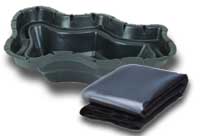
This can be either a rigid pre-formed pond or a flexible sheet liner. Both are easy to install and extremely durable. A pre-formed pond has the advantage of ready made planting shelves and areas for placing submersible pumps though a flexible liner allows you more creativity and a more individual design.
Filters
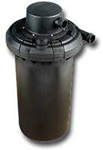
It is unlikely that a newly installed pond will achieve a balance where elements such as vegetation, fish and water conditions work together to maintain a clear and healthy pond. So to help keep the pond water clear, clean and healthy and to avoid unhealthy imbalances which may affect plant and animal life, use mechanical or biological filtration, or a combination of both. An Ultra-Violet Clarifier is highly effective in keeping your pond free of water-borne algae which make the water green. Hozelock Cyprio offers a range of filters to maintain the majority of ponds.
Pumps

A pump is essential for creating moving water displays such as cascades or fountains which, as well as being attractive features, will help to maintain oxygen levels during warm weather. Pumps are also used for circulating water through filtration systems. Hozelock Cyprio offers a comprehensive range of pumps to meet most pond keeping requirements.
Lighting
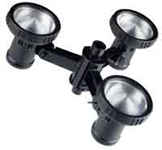
Pond lights are available from Hozelock Cyprio, working off a 24v low voltage system. They are simple to install and enable you to create magical effects at night time.
Adding A Fountain And Waterfall Feature
A water feature can enhance any garden with the water adding crucial, extra dimensions - movement and sound.
Choosing the right type of pond for your own needs is an important first step.
If you have a patio, a bubbler can provide a central focal point, or for nature lovers a wildlife pond will bring into the garden an incredible variety of wetlands wildlife. Fish keepers will appreciate the joy that a well maintained koi pond can give.
Whilst there are no hard rules, ponds and water features fall into 4 categories, each category has specific needs.
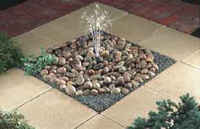
Self contained water feature
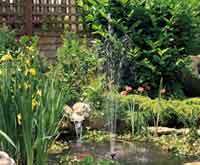
Simple Garden Pond
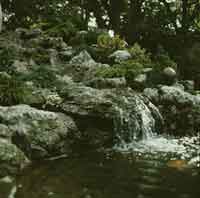
Nature Pond
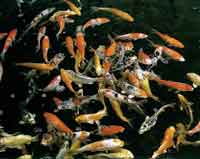
Fish Pond
Fish And Plant Stocking
Why do millions of people all over the world just like you have a garden pond?
A pond is not just a pool of water in your lawn, it's a home for plants and animals. Childhood ponds of your youth may be remembered for being green, but with Hozelock Cyprio your pond can be perfect.
The two most popular elements to pondkeeping and the thing that draws people to having a pond are Fish and Plants.
Without fish or plants a pond is robbed of life, movement and interest.zzz
| Pond size |
Max fish (CM /inches) |
Max flow rate |
|---|---|---|
| 2200L (500gal) | 121cm / 50 inches | 1100L (250gal) |
| 4500L (1000gal) | 242cm / 100 inches | 2200L (500gal) |
| 6500L (1500gal) | 358cm / 150 inches | 3250L (750gal) |
| 9000L (2000gal) | 495cm / 200 inches | 4500L (1000gal) |
| 11500L (2500gal) | 633cm / 250 inches | 5750L (1250gal) |
| 14000L (3000gal) | 770cm / 300 inches | 7000L (1500gal) |
| 16000L (3500gal) | 880cm / 350 inches | 8000L (1750gal) |
| 18000L (4000gal) | 990cm / 400 inches | 9000L (2000gal) |
| 23000L (5000gal) | 1265cm / 500 inches | 11500L (2500gal) |
| 27000L (6000gal) | 1485cm / 600 inches | 13500L (3000gal) |
| 32000L (7000gal) | 1760cm / 700 inches | 16000L (3500gal) |
Fish stocking level based on not more than 55cm per 1000 litres of pond volume (100" per 1000 gallons). Assumes fish at an average of 150mm (6") each
Pond Maintenance
With a little care and attention, a pond can become a beautiful addition to any garden setting. If you follow the guidelines listed below, not only can you enjoy your pond all year round, but you can help to extend the life of your pond equipment and provide clear and healthy water for your fish and plants.
Pumps
Pumps
Pond pumps can be split into two categories, solids handling filter pumps which are designed to convey solids into a filter and therefore, do not include a pre-filter, and fountain pumps which do include a pre-filter, either a fine strainer cage or foam, to protect the impeller and stop the fountain head clogging.
Solids Handling Filter Pumps
The lack of pre-filter means that a minimum of maintenance is required on this style of pump. It is recommended that on a daily basis, the pump is visually checked to ensure that it is performing satisfactorily. On a monthly basis, the pump should be removed from the pond so that the strainer and impeller can be cleaned and freed from any blockages that may have occurred. Finally, on a yearly basis, the pump should be disassembled in accordance with the instructions and all components should be washed in clean, fresh water.
Fountain/Waterfall Pumps
All fountain pumps use some sort of pre-filtration, be it in the form of a piece of foam, or a fine strainer cage. This is to protect the impeller from large solids, algae or fish waste, and to stop the fountain head blocking up. This pre-filtration means that a fountain pump will require more regular cleaning than a solids handling pump, but this is a very simple process. As soon as a reduction in the fountain or waterfall flow is noticed, the pump should be removed form the pond. On most new pumps, such as the Cascade 2000, 3000 and 4000 or the Maxima range, the pre-filter takes the form of a foamless cage. This can simply be wiped clean and then rinsed in clean, fresh water. At this time, you should also rinse out the fountain head in the same way. If your pump has a foam pre-filter, this should be removed from it's holding cage and washed by squeezing out any dirt into some clean pond water. Once reassembled the pump can be returned to the pond.
It is recommended that this process is also carried out on a monthly basis to prevent any build up of algae or fish waste on the pre-filter. Finally, on a yearly basis, the pump should be disassembled in accordance with the instructions and all components should be washed in clean, fresh water.
Tips
- Always unplug and disconnect ALL appliances in the pond from the electricity supply before putting your hands in the water or starting maintenance.
- Never pull on the pump's cable to remove it from the pond. This can damage the seal and potentially shorten the pump's life. Tie some string to the handle to ease removal from the pond.
- Never twist foam when cleaning it, only squeeze it. Twisting foam can dramatically reduce its life span.
- Do not use detergents when cleaning pump parts, only clean fresh water.
- If your solids handling pump is a Prima, it must be stored in water at all times once it has been used, even when not running in a pond, to prevent the seals from drying and cracking.
Should you experience any problems with water quality, or have any questions regarding any of the details given in these pages, you should contact an expert immediately.
Either go to your local aquatics specialist or contact Hozelock Cyprio UK Helpline on +44 (0)1844 292002, or email: Customer Service
All of the above details are guidelines and are no substitute for reading instruction leaflets carefully.
Pond Safety

Water Safety Advice For Garden Ponds

A garden pond is an attractive feature that can be enjoyed by everyone, provided a number of common sense safety precautions are taken. These include safe use of electricity, sound construction and particularly, water safety.
Parents of young children should think very carefully before installing a pond as even a shallow one can be hazardous. Neither should young children be allowed to play unsupervised near water at any time. This is particularly important if you are visiting someone with a garden pond, or if you have young grandchildren.
As an alternative to a pond, parents could consider building a water feature that does not create a pool of water while children are small. Alternatively a metal grill can be firmly fixed over a pond to prevent children or animals falling in. Just fencing off a pond is not recommended as this can lead to a false sense of security - the water is still accessible
For more information or advice please contact Hozelock customer service or telephone (01844) 292002
Electrical Testing

All our electrical products are independently tested to European and USA standards. All electrical products sold throughout Europe conform to the latest and most exacting directives including CE. Hozelock is an ISO 9002, ISO 9001 registered company demonstrating our excellence in the design and manufacture of gardening equipment.



Electrical Installation (240v / 110v).
Hozelock Cyprio pumps are designed to a high standard to be completely safe under water, but care must always be taken to ensure connection to the electrical supply are safe. If in any doubt you must contact a qualified electrician, or contact your local electrical authority. Always follow the basics of electrical safety.
- Never use a domestic plug outdoors.
- Always use a Residual Current Device(UK-RCD, USA-GFI).
- Keep all electrical connections dry and out of the pond.
- UVC's and Bioforce products are weatherproof but must not be submerged in water.
- All mains cables must run through a protective conduit. Bury or cover the conduit, or keep it out of the way so that nobody can trip over it or cut it.
- Water and electricity are a potentially dangerous combination. Consult a qualified electrician if you are in any doubt.
Easy Fit Low Voltage
The alternative to installing 240v / 110v is to install Low Voltage (24v), this system from Hozelock Cyprio, uses a transformer to convert high voltage to low voltage. Low Voltage products from Hozelock Cyprio are easy to install and require no tools or specialist knowledge. The cables do not need to be protected, as it is not possible to receive a dangerous electric shock.
Seasonal Maintenance
Spring
Pond Heaters
Most pond heaters are designed to keep a small area of the pond surface free from ice, and as such can be removed when the threat from ice has passed. This is normally during March but can vary from season to season.
Cleaning
Spring is the ideal time to vacuum your pond. This ensures that the pond will be clean before the temperature gets too high, and thus gives you a head start for the rest of the summer. If your filter was shut down during the winter you should make sure that the filter is thoroughly cleaned before switching it on, as decomposing debris can pollute the pond water.
Frost Damage
Prior to switching on any equipment, a thorough examination of the pond and equipment should be undertaken to ensure no damage has occurred during the winter months. The most common problems are caused by ice, this will primarily affect pipework, stonework, (such as waterfalls) and also the internal parts of an Ultra Violet Clarifier. When you are confident that no damage has occurred, or you have repaired any damage, then the filter system can be installed. However, we recommend installing the filter at a time when regular checks on its performance can be made in case anything has been overlooked.
Re-installing your pump fed filter
The first things that should be installed are the filter and pump. The temperature can still be quite cool when the pump is re-installed, so the pump should be situated in the top third of the pond. When the temperature is consistently reaching 8 degrees and rising, the pump can then be lowered to the bottom of the pond. At this temperature the fish will become more active rather than staying at the bottom of the pond. During the spring is when young fish fry will hatch you may also find Newts and Toads in the pond, which are sometimes quite small and can unfortunately be sucked into the pump. We manufacture a product called the Super Strainer which is designed for the Prima pumps to be sat inside it, preventing the small fry, newts and toads being sucked in. For other pumps you make a cage from planting baskets. The filter and pump should be started 2-4 weeks prior to the commencement of feeding, to give the filter a chance to mature. We recommend that you start feeding when the water temperature is 8 degrees and rising. Starting your filter prior to feeding, allows the filter to begin maturing, through the natural food found in the water during spring. However, it is always a good idea to add Filterstart to the filter, to boost the bacteria colony.
Re-installing your gravity fed filter
When re-installing your gravity fed filter using a Multi Level Inlet, you should only draw water from the top of the pond by blocking off the bottom inlet. If you have installed a bottom drain, reduce the flow rate to help minimise the water temperature dropping. When the temperature is consistently reaching 8 degrees, you can begin to use the bottom inlet on a Multi Level Inlet and increase the flow in a Bottom Drain system to the recommended level. The filter and pump should be started 2-4 weeks prior to the commencement of feeding, to give the filter a chance to mature. We recommend that you start feeding when the water temperature is 8 degrees and rising. Starting your filter prior to feeding, allows the filter to begin maturing, through the natural food found in the water during spring. However, it is always a good idea to add Filterstart to the filter, to boost the bacteria colony.
The last item to be installed should be the Ultra Violet Clarifier. This should be turned on approximately 6 weeks after the filter and pump, or when the Ammonia and Nitrite levels are acceptable, (for ammonia this is between 0-0.25 and for Nitrite 0-0.15) and the fish are being fed daily. The bacteria in the filter breakdown the fish waste so that it is not harmful to the fish. For this reason, care should be taken to ensure that full maturation is achieved as early as possible and certainly before the UVC is switched on, as UVCÕs can greatly effect bacteria maturation.
Feeding
You should test the water every 2-3 days during the first two weeks of feeding
When you first start feeding your fish in the spring, you should feed them on a wheatgerm-based food. This has low protein content but is high in fat, and is ideal for the cooler weather. It produces fewer pollutants and gives the fish the nutrients that they require after the winter. Feeding high protein food too soon can lead to protein froth (foaming), which can be unsightly.
As the temperature rises to 10-12 degrees you can then feed your fish on staple foods. These contain everything needed to keep the fish healthy throughout the summer.
When the temperature rises to 16-20 degrees, you can feed your fish protein or growth/colour enhancing foods. This type of food has added vitamins and nutrients to encourage their growth and colour. There are high protein levels in these types of foods, which can lead to large quantities of waste. Fish waste contains ammonia, which is harmful to fish, and therefore high protein foods should only be used if your filter is fully matured, (i.e. if the Ammonia and Nitrites stay at acceptable levels).
Summer
As long as the correct measures have been taken regarding spring maintenance, summer should be the time when you can sit back and enjoy your pond. However, with some simple checks the summer months will be trouble-free.
As the temperature will now have stabilised, the bacteria in the filter will be active and so the water quality will have levelled out. This also means that parasites and pests will be active so fish should be monitored closely. As this is also the spawning season, the more active the fish become, the more likely they are to harm each others, so again, regular checks should be carried out. Fish spawn and frog spawn, can also encourage protein froth (see Spring- Feeding) which is an ugly foam on the water surface. This can be easily removed using Hozelock Cyrpio from Away.
It has now become peak time for insects. If there is a lot of insect life living in your filter, water clarity may suffer. This is because insects can consume the waste collected in a filter. While this may sound like a good thing, it means that your filter cannot mechanically mature and, therefore, will not work effectively.
One of the most important elements of pondkeeping during the summer months is aeration. Pond plants do give off oxygen in the day, but this process is reversed at night when oxygen is used up and carbon dioxide produced. This is why Hozelock Cyprio always recommends keeping a standby pump to be used in the event of main pump failure. Regular water changes, approximately 10% per month are also recommended to help re-oxygenation, and also to remove the nitrates produced by biological filtration. Regular sludge removal is also necessary as the waste that gathers on the bottom of a pond can also produce carbon dioxide.
When fry have hatched, they will be at risk from predators such as Danselfly and Dragonfly as well as harm from the pump. A cage such as the Hozelock Cyprio Super Strainer can reduce the risk from a pump, but if you wish to ensure the safety of the fry, they should be removed from the pond and held in a separate tank that should also be covered by a net or lid.
The most common job for any pondkeeper in summer is filter maintenance. During the summer more waste is produced by the fish and the higher levels of algae mean more work for the filter, which means more work for you. The filter should only be cleaned when necessary and, while every pond is different, this should mean a regime of one clean every 2-4 weeks.
All of these measures will ensure a healthy and happy summer for your pond's inhabitants and an enjoyable and rewarding summer for you the pondkeeper.
Autumn
Autumn is a time of change for ponds - as the temperature drops so a pond begins to slow down in readiness for the harsher winter months. A little bit of help from the pondkeeper can make this an easy transition for fish and plants.
As the temperature begins to drop start feeding your fish wheatgerm food. This food has a lower protein content but is high in fat, an ideal combination for cooler weather. Feeding should also be reduced as undigested food can cause health problems for fish and protein foam. You should resist increasing the feeding even on warmer days as the fish will still not be able to digest the food fully.
Pond plants will begin to die back during autumn and leaves will fall. Netting over the pond will help reduce the amount of leaves that go into the pond, alternatively regular skimming will keep the surface clear. Pond plants should be trimmed back, again, to reduce the amount of decaying matter that gives off carbon dioxide and can pollute the water. This is also a good time to give the pond a thorough clean-out, removing any silt or sediment.
As autumn turns to winter and temperatures drop further, the fish will move deeper in the pond and become less active. Feeding should now be stopped completely and the pump raised off the bottom of the pond so the bottom layer of water is not disturbed.
Performing these simple tasks will keep the potentially stressful transition from summer to autumn as easy as possible for the fish and other aquatic wildlife.
Winter
Winter Filtration
The various options available to the pond keeper as the winter approaches, fall into two main categories:
- Continuation of filtration.
- Removal of filtration.
The decision is primarily determined by comparing the benefits of continuing filtration, which will help to sustain some degree of biological colony and reduce the risk of the pond freezing over, compared to the running cost and danger of low oxygen due to freezing.
From a biological point of view, the continuation of filtration in a heated pond is essential. In an unheated pond, continuation will improve the speed of biological maturation at the beginning of the following season and give some protection in the event of winter warm spells.
Winter Running for Unheated Ponds
For winter running of unheated ponds, here are a few tips to ensure that your fish have a happy winter:
Gravity Fed System
If the inlet system is a Multi Level Inlet, the bottom inlet should be closed off so water is only drawn from the top of the pond. If a bottom drain is being used, a reduction in the flow rate can help to minimise the water temperature dropping.
Pump Fed System
Position the pump in the top third of the pond and closer to the filter release point. This will reduce the circulation and allow the bottom of the pond to remain warmer.
General Points
Remember that returning water helps to prevent the pond surface from freezing, which help the oxygenation of the water. Therefore, the returning water pipe(s) should release above the surface of the pond (if the surface of the pond is moving, it will freeze at a lower temperature).
If you have a waterfall, fountain or venturi, they should be bypassed or switched off, as the exposure of the water to the cold air, causes a chilling effect which can be harmful to the fish.
You should switch off, drain and remove the Ultra Violet Clarifier if there is any risk of freezing. If the water is allowed to freeze inside the UVC, the expansion of the ice will cause the quartz tube to crack.
By leaving the filter system running in the winter you will find that your filter will mature quicker in the spring ready for the new season.
If severe weather is predicted, switch off and drain the entire system (see Winter shut down section for details).
Winter Running for Fully Heated Ponds (not a floating pool heater)
As the purpose of heating a pond during the winter is to maintain continuous summer conditions, we advise that the filtration system be run as in the summer months. However, the following are a couple of points to ensure that all goes well:
If the heating system of the pond should fail, the water temperature could fall rapidly, which would be harmful to both the fish and the biological colony. We therefore recommend that a backup heating system is available.
If the filtration system is installed above ground, try to insulate the outside of the filter to avoid heat loss.
If there is any risk of the system freezing, you should switch off, drain and remove the Ultra Violet Clarifier. If the water is allowed to freeze inside the UVC, the expansion of the ice will cause the quartz tube to crack.
Avoid using waterfalls, fountains and venturis as these will chill the pond. This will increase the costs of heating and may also lead to areas of the pond being at different temperatures.
Winter Shut Down
If you wish to shut down the filter systems during the winter months, we would recommend the following:
The system should be left to run for at least 2 weeks after feeding has stopped and restarted approximately 3 weeks before feeding commences in the spring.
Never feed your fish whilst the filter is out of operation.
Once removed, the filter and UVC should be thoroughly cleaned with tap water and stored indoors.
If removed, the pump should be cleaned and stored indoors. If the pump is a Prima, it should be kept in a bucket of clean water to prevent the seals drying out and cracking.
If the entire system is removed, we advise that a small pump is used to disturb the pond surface or a floating pool heater is installed. This is to try and prevent the pond from freezing over to allow oxygenation of the water.
Winter Maintenance
Whether the filtration system is removed or run during the winter, it is a good idea to do a little cleaning before the weather becomes too bad. We would recommend the following:
The pond plants will start to die off as the weather becomes colder, we would advise that the plants be trimmed back to ensure that the dying plants do not pollute the water.
During the season, the base of the pond may have developed a layer of silt and sediment. We recommend that this should be removed with the use of a Cypri-Vac or similar device.
Please note that the above recommendations are based on our experiences over the years and not intended to be a definitive procedure or guide. Particular care should be taken with small ponds, if moving water is used to prevent freezing over, the chilling effect is very hard to avoid. In this situation it may be safer to shut down the filtration system and use an alternative method of preventing freezing. If, however, you are in any doubt as to what action to take during the winter, consult your local specialist.